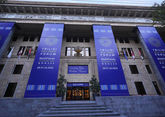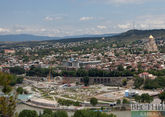There is some debate as to how many countries are part of the Belt and Road Initiative, which sprawls across the Middle East as far as eastern Europe and Egypt. ICBC Standard Bank’s Belt and Road indices track 65 countries (including China). One of the smaller nations along the way is Armenia, a landlocked state in the Caucasus, bordered not by China but by Turkey, Georgia, Azerbaijan and Iran. Euromoney reports in its article Making sense of Belt and Road – The Belt and Road country: Armenia that Armenia’s GDP is $10.55 billion; China’s, $11.2 trillion. How is such a country, more than 1,000 times smaller than its partner, affected by being named part of Belt and Road?
The first thing to realize is that there is no formal process of notification: no big ceremony when China tells a country it is part of the Belt and Road. “There is no formal invitation to the country,” says Hrant Abajyan, Armenia’s trade representative to China in Beijing. Armenia heard about it like everybody else did, when Xi Jinping made his speech at a Kazakhstan university in 2013. Regardless, Armenia is delighted to be part of the club. “We are convinced this project will play a very important role in the development of relations among the countries participating in it,” not just in terms of economic development “but culturally, in the cultivation of tourism and in people-to-people relations,” says Abajyan. “From the very beginning, Armenia has been deeply convinced it can and must be an integral and indivisible part of this initiative.”
It is easy to see why. Armenia is one of the weaker economies on the road, ranking 50th for economic health, 54th for macroeconomic performance and 42nd for risk outlook among the 65 members in ICBC Standard’s ranking. It has clear needs for infrastructure and will welcome China’s help in building it. Armenia is, in the best possible sense, in the way: inserting itself in both east-west and north-south trade flows will be very much to its benefit. “We have an opportunity to act as a regional transit hub, for transport, freight and communications,” says Abajyan. Two big examples are the North-South road corridor, a highway that will go from the border with Georgia in the north to Iran in the south, and the Southern Armenia Railway, a potentially important supply route into Europe from Iran. Abajyan names both in relation to Belt and Road; Chinese companies have been involved as both investors and contractors in the first three tranches of the road’s development, are negotiating to be part of the fourth and will no doubt be part of the final fifth. The railway is still at the negotiation stage, but China Communicating Company has already developed a feasibility study.

'No compromises'
So how does it work? Does a country go to China and suggest a project be part of Belt and Road? Or does China come in and offer to build something it thinks is practical? In Armenia’s case, it is more the former. Armenia’s government has developed 50 investment projects around the country, some of which will suit international capital, and through Armenia’s diplomatic corps in Beijing, it has been making sure China is aware of them. But is there a compromise in accepting Chinese funding? What’s expected in return?
“There are no compromises because there are no problems,” says Abajyan. “There are no issues that don’t match each other. The Chinese government has always been a friendly nation for Armenia. We are in a great relationship.” It is a relationship tilted in one direction, but then again so is pretty much every country’s relationship with China. Abajyan says it is too early to talk about knock-on effects in other areas of the Armenian economy, such as its banking or legal systems, but it is expected that countries on the BRI will feel the influence beyond infrastructure. Infrastructure is obviously a catalyst for economic growth across a range of sectors, but further still, it may prompt the development of local currency bond markets to fund that infrastructure, and perhaps prompt the development of foreign investment laws and a legal services industry that may have greater utility beyond Belt and Road. “The mechanism here is simple,” Abajyan says. “The more investment you receive as a country, the more developed you become, and the more you get integrated into the regional, sub-regional and international markets for projects. And the more the economy grows.” A small country in this position is naturally going to welcome Chinese investment with open arms.










